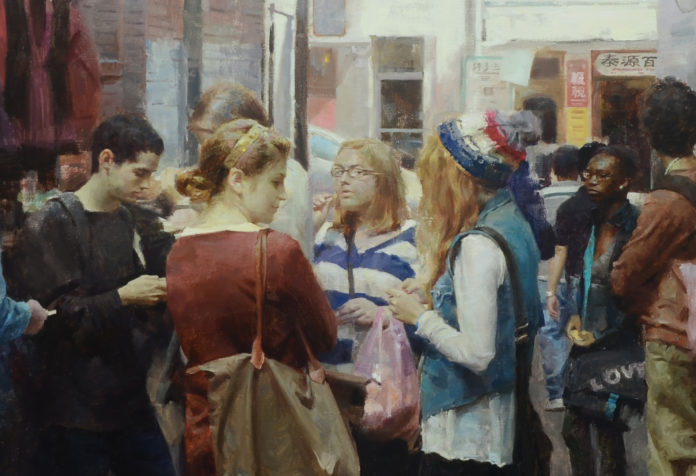On Painting Composition > What should artists do to get their message across to the viewer?
By Huihan Liu
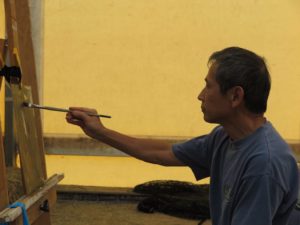
I found that if I have a vision for the piece and can picture in my mind what I want the finished piece to look like, I can usually work out the problem easily. The subject matter is usually the motif. But how to set the mood and color palette? It took me longer to work out the vision for a painting I am happy with. Whether a quiet, peaceful piece or a busy and exciting piece full of movement, whether sunlit or moonlit, the heart of a painting is about taking my feeling and hopefully evoking it in the viewer, rather than merely describing a thing.
Since childhood I have always loved to draw everything around me. The fascination was with the simplest of shapes — whether a human gesture or the branch on a tree. It was fun at the time, but to draw it quickly required simplifying what I saw. Later, in art academy, intensive study helped me understand the essential elements, and progress to larger studio work. However, thinking of how to simplify before developing the narrative has been key for me to paint successfully.
[Learn about Huihan Liu’s new PaintTube.tv art video workshops here]
Besides painting from life, most of my initial studio painting ideas come from casual snap-shots: pictures taken during field trips, street scenes, models in rest poses. I first try to look at the picture, not as the actual object in real life, but to visualize an abstract element that has an appealing aesthetic quality.
For example, a backlit light on a silhouetted shape, the lost and found of edges, value keying, the mood and feeling — these visual effects can then be broken down in many ways, such as tonal structure and pattern, rhythm and movement, color harmony and space balance, or repetition. Each of these represents a certain kind of mood and feeling, so each painting can be unique, rather than formulaic.
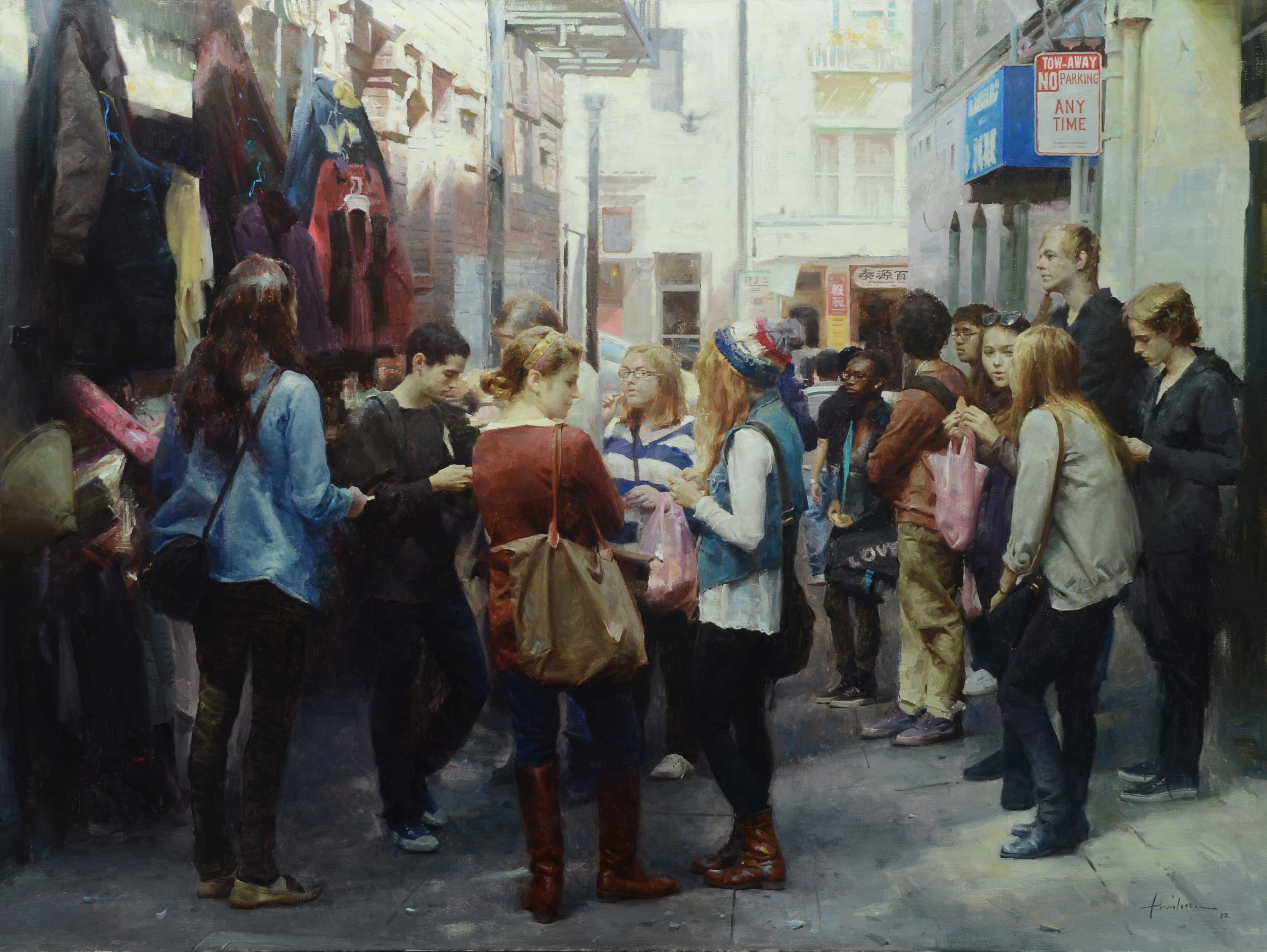
Shopping Day in Chinatown, S.F. (above) depicts a casual scene I saw in a historical back alley in San Francisco’s Chinatown. My main interest was the design proposed in the unity of people within the variety of individual characters in the composition — to show the way our eyes can switch back and forth between first viewing this scene as a group of distinct individuals, and then again as a crowd.
I first grouped all small, similar dark values as a major shape, breaking up it up within using small patterns in different values and colors on the cloth. Secondly, I used casual overlapping and cropping to create depth and perspective. I like the overcast light in the alley, and the soft cast shadow beautifully contrasted against the accent of small patterns.
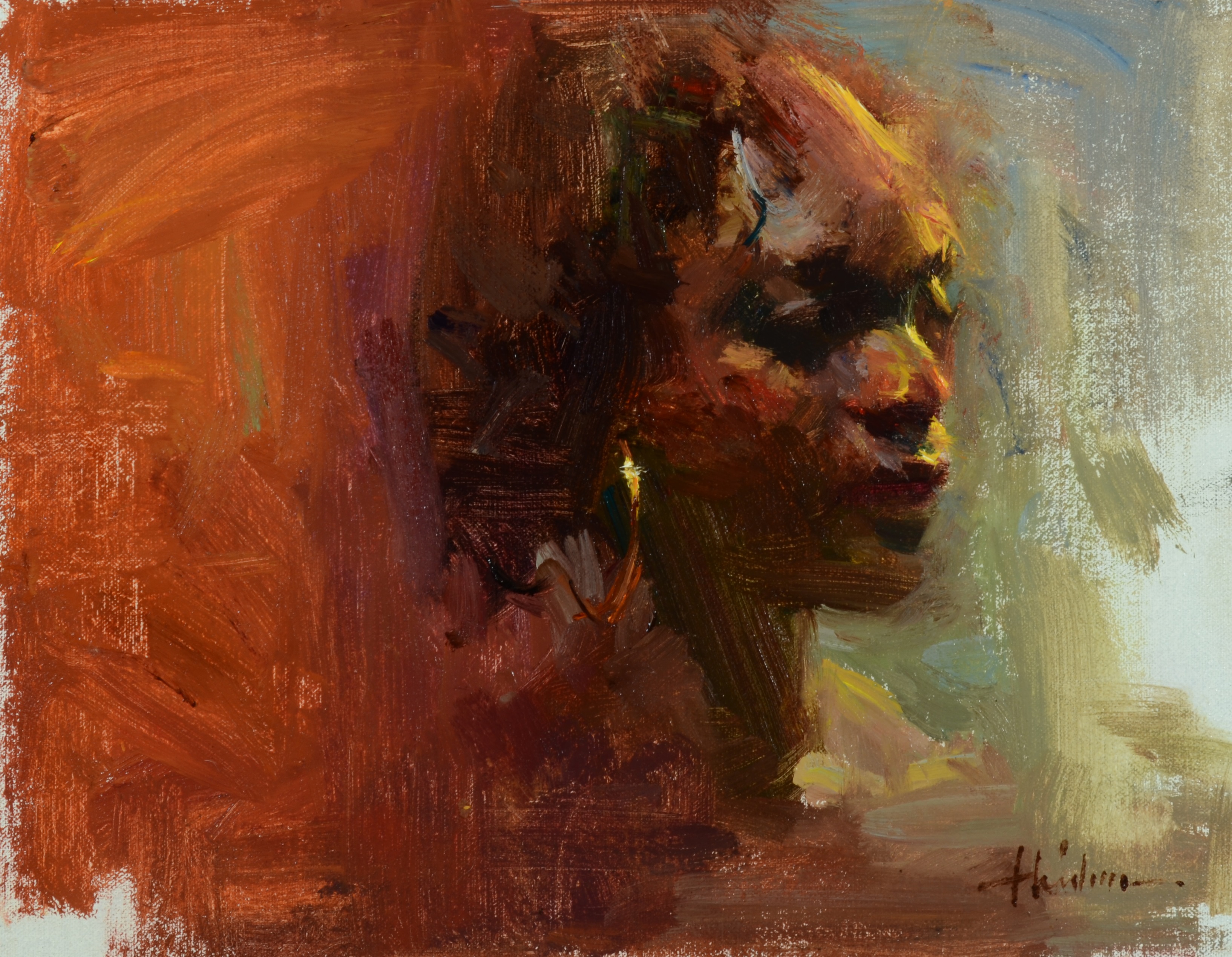
”Amber Light” (above) was done as a painting demonstration. The idea was to play around the warm and cool color temperature on the figure’s head. I set up the subject under a fluorescent track light with the addition of a warm accent light from a 45-degree angle to the side of the figure’s forehead, nose-bridge, and upper lip. The fluorescent light produces a cool-accent light on the frontal bone above the eyebrow and the cheekbone, creating a beautiful transition from cool light to the halftone, representing the local color of skin tone to shadow.
I used a 2-inch sized bristle bright, a #10 bristle Filbert block in most of the figure planes and background, choosing small-sized brushes to build up the small shapes, and a #4 fan bristle brush for the warm accent light with impasto paint to achieve the textural layers and the soft edges. The final stage was to make whatever necessary adjustments to push the light accent, refine key details, and sharpen edges with the shadow area and background.
4 Painting Composition Tips for Artists
1. Simplify painting ideas! I have learned from hard experience that a painting fails not because I did not put enough effort into it, but because I had a confused initial idea and tried to incorporate too many ideas into a single painting. Each painting must have its own limitations. For example, if the painting is about tonal structure, the color should be less important than the value key arrangement, and one must be sensitive to the tonal relationship, grouping all closely related values with the larger shape, establishing basic placement of light, gray, and dark values before developing any smaller values. Stick to one idea for each painting. If it still does not work, learn why and go on to the next idea.
2. Establish a focus point. The focus point depends on what you want to say; for example, maybe the feeling of a foggy day with a small figure in the distance, or the portraiture, or the vantage points of the street. But too many focus points will distract the viewer and weaken the message.
3. Be selective, and do not overstate. Composition consists of finding a satisfactory unity within a variety of possible relationships. When working on a larger painting, it is very easy to get lost in the details when one relies on picture references. Take time off from larger works and come back with a fresh eye.
4. Have a curious mind. Sometimes I try to paint in a different way in small studies, because it frees my mind to not worry too much about the outcome, and helps develop new ideas and techniques that can be explored in later pieces. Joaquín Sorolla (Spanish painter, 1863-1923) was a great inspiration when I visited his home museum in Madrid.
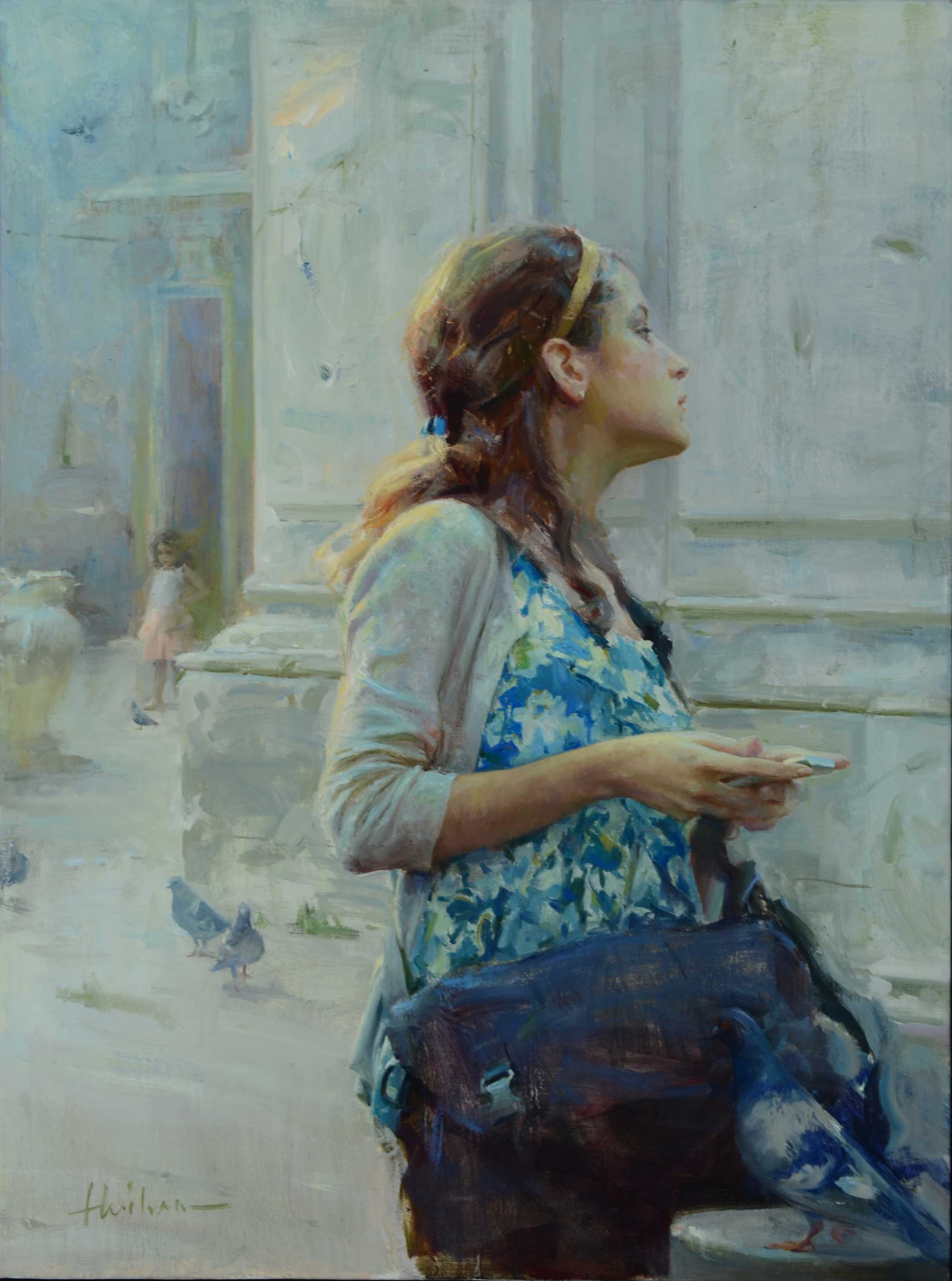
My idea for “Looking Back” (above) was a contemporary figure inspired by the methods of a late-19th-century group of Naturalist artists. Soft and mute, the focus was the beautiful figure under an overcast light. The reference was a snapshot taken on the street with an AF VR Zoom-Nikon 80mm-400mm long lens attached to the camera while randomly shooting from a distance.
The figure peers slightly upward from the side view with the soft light highlighting her beautiful bone structure and light skin tone on the right side of the face that creates an almost lost-and-found edge towards the background. The face structure on the light side is hinted at by shadows underneath the eye socket, nose, lip, and chin. Overall, the head, shoulder, and torso were a fabulous relationship to paint.
Once I blocked in the basic transparent tone, I started work on her face, really paying attention to the transition from light to shadow. To get soft skin tone effects, one should avoid rugged brushstrokes — I used a sideway sable brush stroke to gently overlap new paint over previous layers to unify the skin tone transition.
I think the subtly cool blue-greenish palette works well for the painting. The blue flower-patterned cloth on the figure was the flat, central shape of the design. My idea for the piece was not only to have a well-developed, finished quality when viewing from a distance but to also enjoy the textured brushstrokes and layers when looking closely.
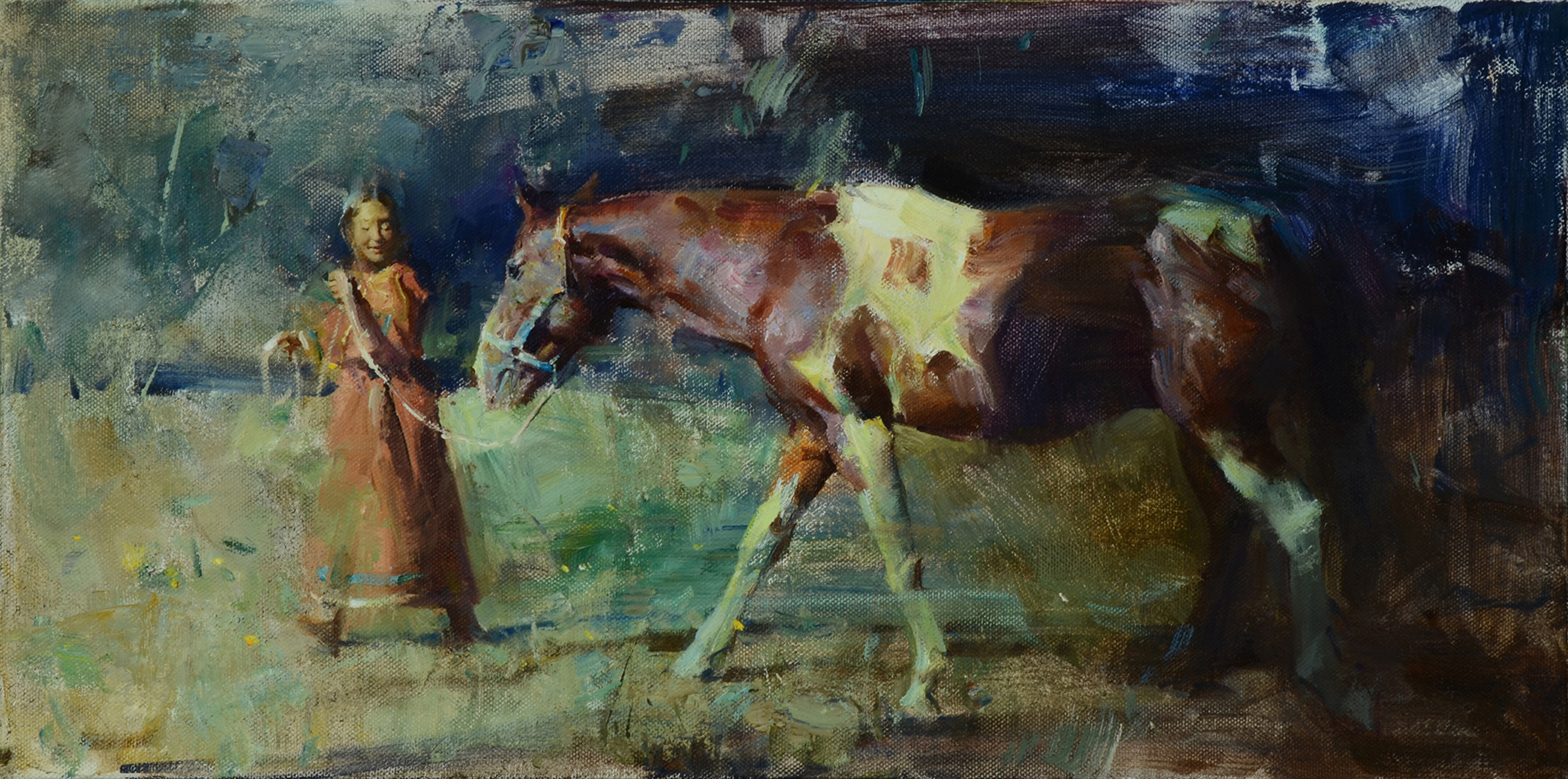
The reference photo for ”Faithful Friends” (above) was taken on a sunny day, but I changed the daylight picture to a night scene. Except for the different color temperatures, the shapes of light and shadow were pretty much alike. The idea for the piece was fun because it allowed me to explore the color palette and abstract elements in a representational manner.
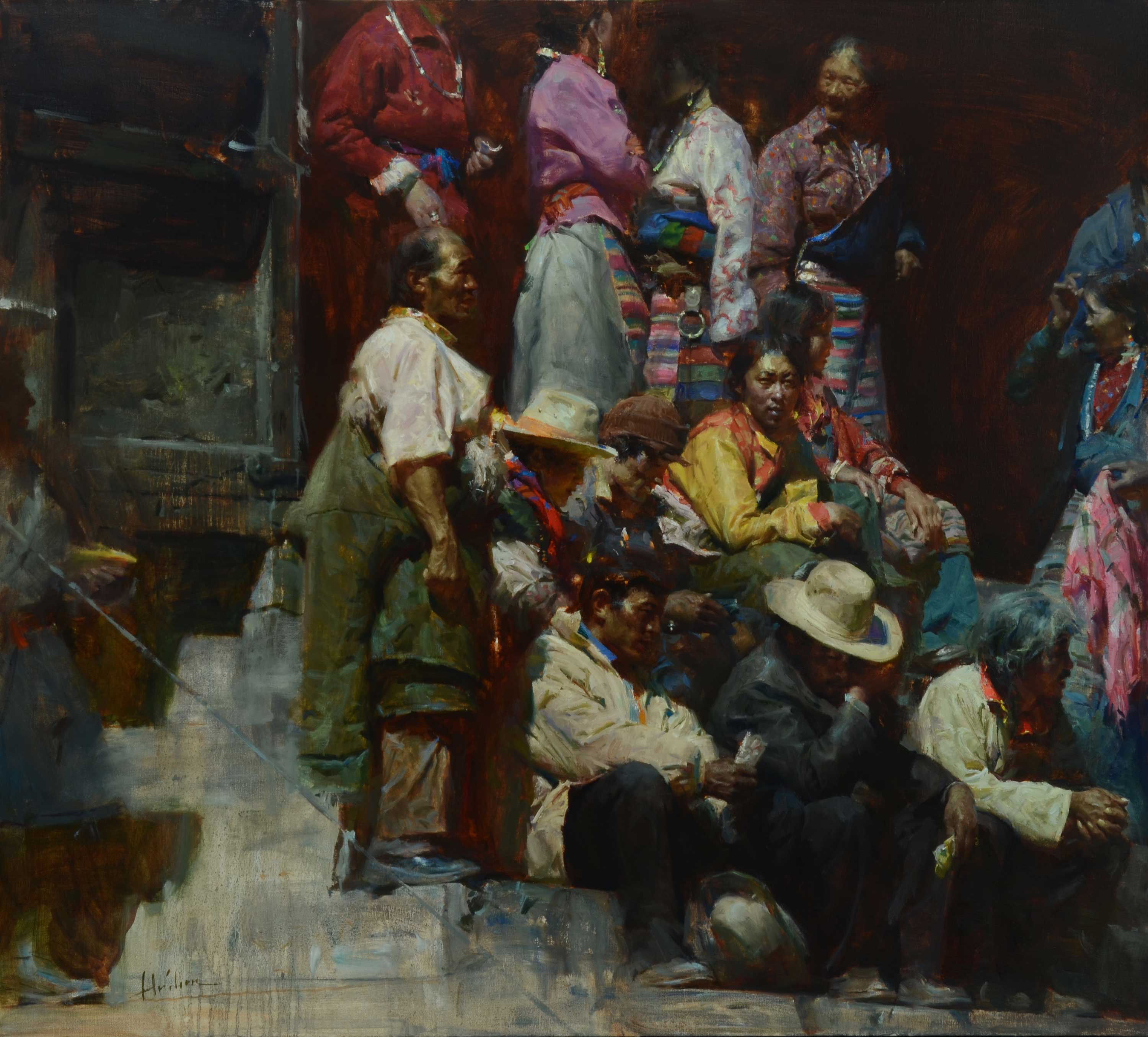
The scene for ”Pilgrims Gathering” (above) was from a trip to Tibet in 2004, at the Shigatse-Tashilhunpo Monastery. The initial design for the piece was the abstract placement of the figures and the strong contrast to convey the meaning of the piece. I wanted the viewer to first pay attention to the group of figures before the individual.
The dark V-shapes in the background were placed to balance the overall composition. The cropped figures have a more natural-looking gesture within this dynamic design. The paint application was impasto with layers built up in the light, allowing the warm underpainting to show through.
This article was originally published in 2019
Preview Huihan Liu’s art video workshop Expressive Figure Painting:
Related Article > Step-By-Step Demonstration: Creating a Composition


